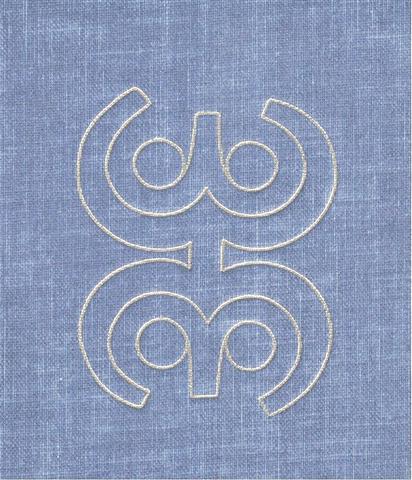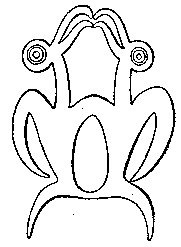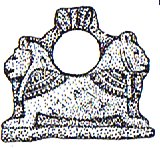|
TRANSLATIONS
Here, at the beginning of side b, it is necessary first to recapitulate what has been learnt from side a. Before giving such a summary, however, a few reflections left over from side a should be noted down: GD71 (makemake) as seen in Eb6-24 perhaps is to be turned 90º leftwards (in our minds) into:
First (at left) the 'eyes' are 'inside' (ki roto), then (at right) they are 'outside' (haho). The shape at left corresponds to p'u (GD24), the shape at right to viri (GD33):
The midsection in Eb6-24 (like an arrow with head at right) may depict the 'nose' of Makemake. We should remind ourselves about what earlier was written:
Nothing in this needs to be changed so far, but additions may be made according to what has been learnt lately, e.g. about the relations between GD71, GD24 and GD33 and takurua. These additions should be documented in the 'signs chapter' of GD71. Although it may be a coincidence it should here anyhow be noted that the Hawaiian ike ('to see' or 'to know sexually') remarkably well harmonizes with possible events at 'noon' (Poike) in Aa1-26:
'...The divine names Bran, Saturn, Cronos ... are applied to the ghost of Hercules that floats off in the alder-wood boat after his midsummer sacrifice. His tanist, or other self, appearing in Greek legend as Poeas who lighted Hercules' pyre and inherited his arrows, succeeds him for the second half of the year; having acquired royal virtue by marriage with the queen, the representative of the White Goddess, and by eating some royal part of the dead man's body - heart, shoulder or thigh-flesh. He is in turn succeeded by the New Year Hercules, a reincarnation of the murdered man, who beheads him and, apparently, eats his head. This alternate eucharistic sacrifice made royalty continous, each king in turn the Sun-god beloved of the reigning Moon-goddess. But when these cannibalistic rites were abandoned and the system was gradually modified until a single king reigned for a term of years, Saturn-Cronos-Bran became a mere Old Year ghost, permanently overthrown by Juppiter-Zeus-Belin though yearly conjured up for placation at the Saturnalia or Yule feast ...' We must, of course, here also review what glyphs surround Eb6-24. From Tahua we have learned that the lines could be used as a way to divide the text into parts. Therefore we had better start already from the beginning of line b5 in Keiti (although there is no great 'break' in the calendar between Eb4-42 and Bb5-1):
Then follows the rest of line b5, maybe as a kind of introduction to line b6:
Here we should note GD13 (rei) at Eb5-32, a glyph type 'not yet quite understood' (meaning total ignorance of course). I believe we are now in a position where we may be 'enlightened'. First we list all GD13 I have found in Tahua:
11 of the glyphs are combined with GD11 (manu rere). Possibly I should have added one more glyph to reach 12, and if so that ought to be the one coloured black above (with a shark at right instead of a bird at left), i.e. Aa8-35. We remember that GD13 is connected with GD11 also in Saturday (Hb5-56, Hb5-58) and at the 'crossing over place' (hakapekaga) in Ca5-20--22, though with GD11 arriving after GD13. Having sorted away all complex glyphs there remains 8 on side a and 8 on side b:
Although there is a wide range of variability in form I have tried to group some of the glyphs together. Next the meanings of the word rei need to be looked at:
With red I have marked meanings implying death by force (as when a fire is 'put out') or the result thereof: 'a spirit' (the 'ashes' after a 'finished fire'). One tooth (tambua) was the ransom to be payed, one otter got away from being strangled, and at Aa1-1 one shell is left behind by the baby sun. Especially noteworthy is: Îka reirei, vanquished enemy, who is kicked (rei). The 2nd sun may be one of those who are 'kicked' to death. Remember the strange choice of words at the kava ceremony: '... There is a further motivation of the same in the kava taken immediately after the chief's by the herald, a representative of the land. This drinking is 'to kick', rabeta, the chief's kava. Raberabe, the same reduplicated version, means 'a sickness', the result of kicking accidently against a 'drau-ni-kau'... The herald here takes the effects on himself: drau-ni-kau is the common name for 'sorcery'...' The 'kava' ceremony in Thursday has no GD13 glyph. Maybe Hb9-42--43 gives the same meaning by way of another expression:
The head of the chief is needed for growth, so 'of course' he has to 'go'. As written earlier at Aa4-63:
'... The skull of a dead king could be symbolically represented by hua respective rei miro: '... Up to the present time, fertility spells for fowls have played an important role. Especially effective were the so-called 'chicken skulls' (puoko moa) - that is, the skulls of dead chiefs, often marked by incisions, that were considered a source of mana. Their task is explained as follows: 'The skulls of the chiefs are for the chicken, so that thousands may be born' (te puoko ariki mo te moa, mo topa o te piere) (Englert 1939:240). As long as the source of mana is kept in the house, the hens are impregnated (he rei te moa i te uha), they lay eggs (he ne'ine'i te uha i te mamari), and the chicks are hatched (he topa te maanga). After a period of time, the beneficial skull has to be removed, because otherwise the hens become exhausted from laying eggs ...' Line Eb6 begins with showing how there is a gap between the two seasons (presumably the 2nd half of last year and the 1st half of the new year):
The two 'eyes' in Eb5-35 are similar in meaning (I believe) to the two 'eyes' inside henua in GD24 (pú). In Eb6-2 we can see 5 marks, presumably telling us that there are 5 'dead' (GD45, ihe) nights in between the two ordered seasons ('... the order, the world of forms generated by the chief ...'). A remarkable picture from Heyerdahl 6 must be inserted here as a kind of parenthesis:
"Design carved on head of Easter Island wooden image. (From Routledge 1919.)" The similarity with GD59 gives the design a double meaning:
The oval form on the stomach is probably a hole, and we remember aker, the symbol at the threshold between day and night:
Line Eb6 continues:
The 24th 'sun cat' is transformed into a shark:
The reversed GD45 (ihe) of Eb6-9 is unusual. I have seen a reversed ihe in just one more place, at Cb8-9:
Here the extraordinarily broad Cb8-7 immediately makes one think of the design we saw above, with double 'birds' (i.e. gods) creating an opening for the sun. The form shaped by the wings in Cb8-11 suggests GD33 (viri).
"A Senegal Parrot chick at about 2 wks from hatching. The egg tooth is near to the tip of its beak on the upper mandible. An egg tooth is a small protuberance on the beak or nose of vertebrates that are hatched from eggs, i.e., birds and reptiles. Some lizards and snakes develop a true tooth that is shed after use; birds and other reptiles generally develop an analogous epidermal horn that is reabsorbed or falls off. Both varieties of egg tooth assist in the breaking or tearing of the eggshell, a process known as pipping ..." (Wikipedia) Maybe tambua is an 'egg tooth': '... Mother of pearl; rei kauaha, fin. Mgv.: rei, whale's tooth. Mq.: éi, id. This is probably associable with the general Polynesian rei, which means the tooth of the cachalot, an object held in such esteem that in Viti one tooth (tambua) was the ransom of a man's life, the ransom of a soul on the spirit path that led through the perils of Na Kauvandra to the last abode in Mbulotu. The word is undoubtedly descriptive, generic as to some character which Polynesian perception sees shared by whale ivory and nacre ...' The tara at winter solstice may mean the spur in front (the 'egg tooth'). |
|||||||||||||||||||||||||||||||||||||||||||||||||||||||||||||||||||||||||||||||||||||||||||||||||||||||||||||||||||||||||||||||||||||||||||||||||||||||||||||||||||||||||||||||||||||||||||||||||||||||||||||||||||||||||||||||||||||||||||||||||||||||||||||||||||||||||||||||||||||||||||||||||||||||||||||||||||||||||||||||||||||||||||||||||






















































































